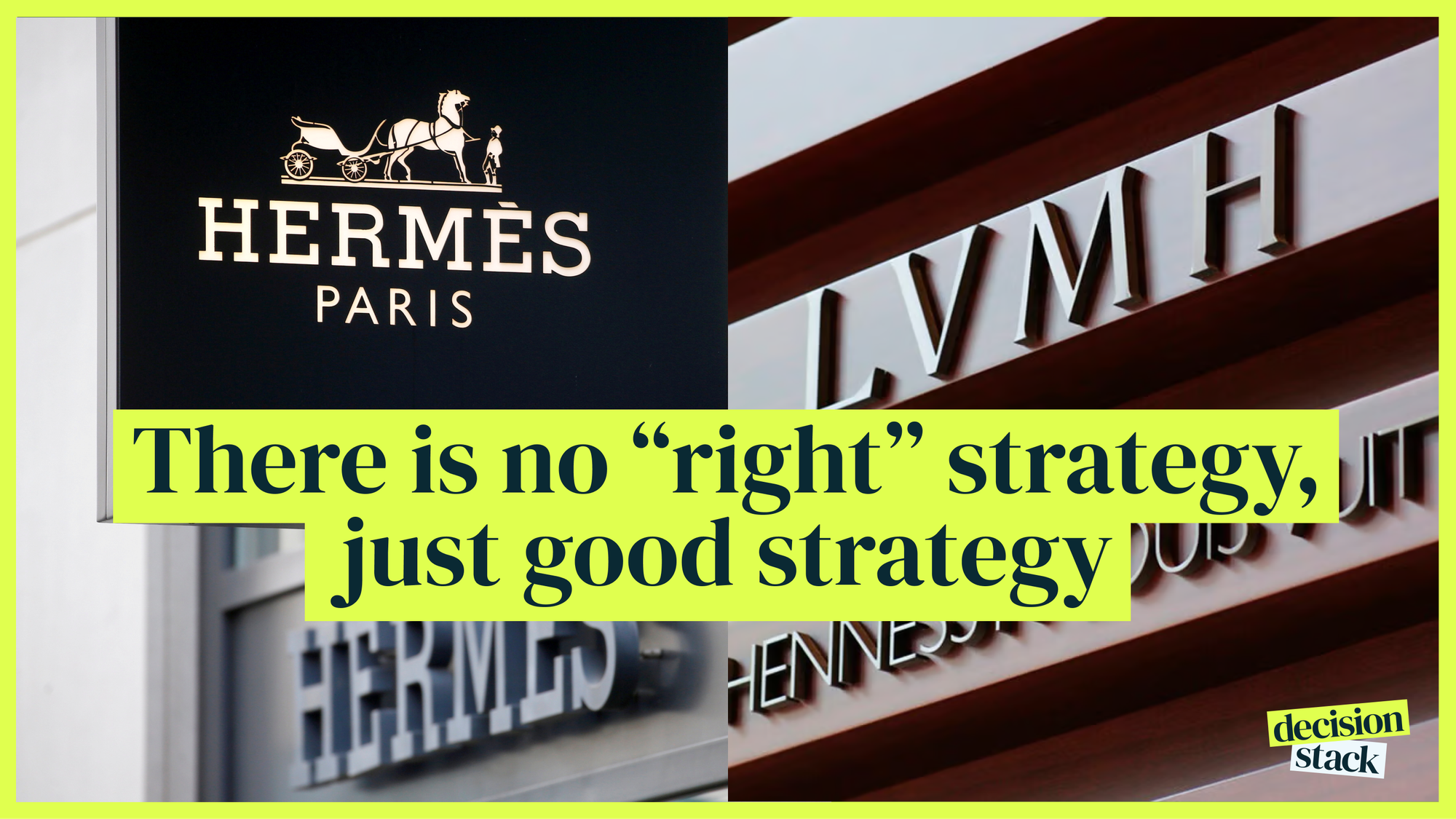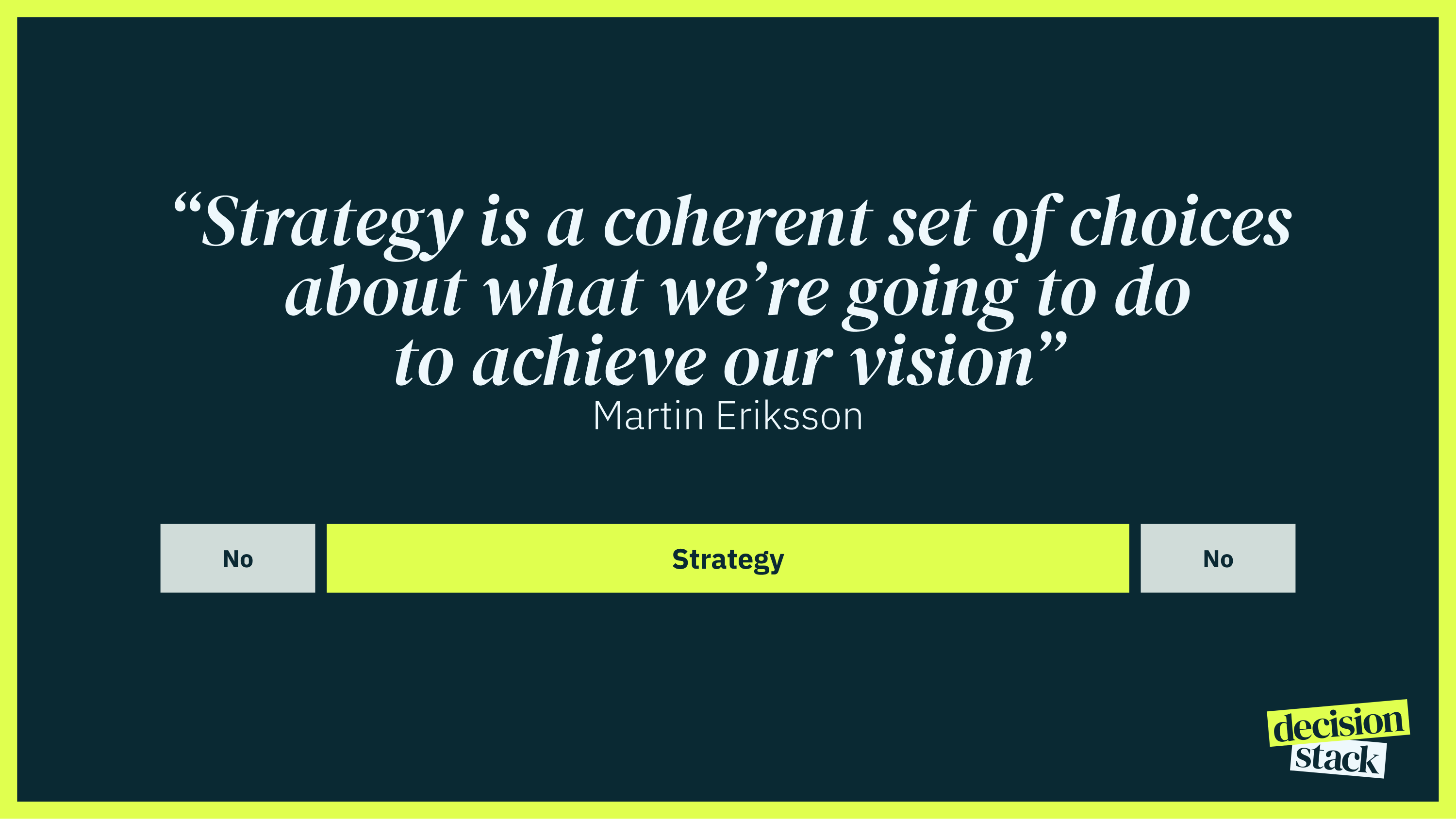Hermès and LVMH Prove That There is No "Right" Strategy
The success of luxury titans Hermès and LVMH underline that strategy is about making choices - and then executing coherently on those choices.

One of my favourite podcasts is Acquired, which tells the fascinating stories and strategies behind some of the biggest and most famous companies in the world. Most recently I listened to the histories of Hermès and LVMH, and realised they are the perfect example of something I’ve long talked about - there is no “right” strategy, just good strategy.
Too often we agonise over strategy, worried about making the "right" decision and end up in analysis paralysis instead - never committing to a clear choice, and never really making progress because of it. But as Hermès and LVMH show, making a clear choice and executing coherently based on that choice can pay huge dividends.
“Strategy is about making choices, trade offs; it’s about deliberately choosing to be different” - Michael Porter
How Two French Families Came to Dominate Luxury
Hermès and Louis Vuitton (now a cornerstone of LVMH) started out very similarly, founded within 17 years of each other in Paris. Hermès started with bridles and harnesses for the horse drawn carriages of the nobility, and Louis Vuitton the trunks and luggage they put on them. Both won the custom of Empress Eugénie, wife of Napoleon III and a prominent figure in 19th-century France, who epitomised luxury and sophistication. In the 1890s, both started adding product lines and expanding internationally.
Fast forward nearly a century to the 1980s, and both were struggling (along with most of the luxury industry) due to the challenges of scaling. Until then luxury had always been about high quality handmade goods, which makes scaling production to a global scale really difficult. In 1987 Louis Vuitton merged with Moët Hennessy to form LVMH, and in the ensuing merger investor Bernard Arnault quickly took over the reins as CEO and drove a new strategy: LVMH would consolidate many brands under one roof and leverage the resulting economies of scale in outsourced production, advertising, and more. Today, in addition to Louis Vuitton, Moët, and Hennessy, LVMH's portfolio owns and operates 75 brands, including household names like Christian Dior, Givenchy, Fendi, Celine, Kenzo, Tiffany, Bulgari, Loewe, TAG Heuer, Marc Jacobs, Stella McCartney, Sephora, and Loro Piana. None of those brands make their products in house, but they leverage huge economies of scale on shared outsourced production as well as brand and advertising. Hermès took a very different approach. Despite similar advice from consultants to outsource production and cut costs, the family run business doubled down on their artisanal approach in the 1980s and almost all of their products are still individually made by hand by a single artisan.
Two Diverging Strategies
So we have two clear, but contrasting, choices: Optimise for economies of scale vs optimise for quality. If you reference Hamilton Helmer’s 7 Powers in my Strategy Toolkit, you would say LVMH chose to pursue Scale Economies and Brand power while Hermès chose Brand, Cornered Resource (of artisans), and to some extent Counter Positioning power. If you were in those rooms in the 1980s neither would have been an easy choice, but they both made a clear choice and most importantly implemented coherent strategies to deliver on those choices.
The results are quite different, though both are hugely successful companies:
| LVMH | Hermès | |
|---|---|---|
|
Revenue (Q1-Q3 2024)
|
€61 billion
|
€11 billion |
| Growth | -2% | +10% |
|
Net Margin
|
18% | 31% |
|
P/E Ratio
|
23x | 32x |
|
Market Cap (Jan 2025)
|
€350 billion | €260 billion |
There’s no clear winner here - LVMH is much bigger than Hermès, but the latter is growing faster and has better margins so commands a stronger p/e ratio. Whichever one you backed in the 1980s would have been the right choice - they have both catapulted their owners into the top 5 wealthiest families in the world.

Why Making a Choice and Executing is More Important than Agonising over the Right Choice
Great strategy is all about making choices. Not just the easy ones, like which opportunities to chase, but the hard ones—what not to do. These decisions are where strategy lives because they force you to focus your energy and resources on one direction. Without those clear choices, you end up spreading yourself too thin, trying to do everything and excelling at nothing.
When you make deliberate, intentional choices, you create clarity. This clarity aligns your team and gives everyone a shared sense of direction. That's what the Decision Stack is all about.
And it’s not just about internal alignment—it’s about standing out. Great strategy means differentiating yourself in a crowded market, creating a unique position that customers can’t ignore and competitors can't copy. That kind of focus only happens when you choose one path and commit to it.
People think focus means saying yes to the thing you've got to focus on. But that's not what it means at all. It means saying no to the hundred other good ideas that there are. You have to pick carefully. - Steve Jobs
What’s striking about both LVMH and Hermès is how consistently they have executed on their strategies. LVMH has grown by acquiring more and more brands and leveraging their economies of scale to drive better quality and cost control with their suppliers and advertising channels. Hermès has overcome their scaling challenge by relentlessly focusing on their artisanal model, where they build small (max 250 people) factories "métiers" and even build their own schools to teach the crafts they need to continue hand making their products. Even their corporate structures reflect their visions and strategic choices - they have both limited their public market float so that they can maintain control and relentlessly focus on their vision and strategy. Each set of actions is coherent with their chosen strategy. They are both a masterclass not just in luxury, but strategy.
How clear are the choices and how consistent is the execution in your strategy?

